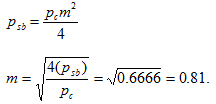This set of Avionics Multiple Choice Questions & Answers (MCQs) focuses on “Sidebands and Frequency Domain”.
1. What is the wave of frequency that occurs at the sum and difference of the carrier and modulating signal is called?
a) Noise signals
b) Sideband
c) Extraband
d) Neutral band
View Answer
Explanation: New signals at different frequencies are formed when an intelligence signal is modulated with a carrier. These signals are called sidebands and usually have the frequency of the sum and the difference of the carrier and the modulating signal.
2. What type of display will give us clear information on the signal if it is made up of different frequencies?
a) Frequency domain display
b) Amplitude domain display
c) Time domain display
d) Bandwidth display
View Answer
Explanation: When a waveform is made up of waves of different frequencies the amplitude information is not enough to fully understand the wave and its propagation characteristics. In this case, a frequency domain display is used where the frequency of each separate signal is shown according to its frequency and amplitude with respect to time.
3. What is the upper sideband frequency if the carrier frequency and the modulating signal frequency is 30 KHz and 80 Hz respectively?
a) 3000Hz
b) 30.8KHz
c) 3080KHz
d) 30.8Hz
View Answer
Explanation: Upper sideband frequency = carrier frequency +modulating signal frequency = 3000Hz + 80Hz = 3080Hz = 30.8KHz.
4. What is the maximum carrier frequency to be used if the upper limit frequency that is available is 4000Hz and the frequency of the modulating signal is 100Hz?
a) 4100Hz
b) 4000Hz
c) 400Hz
d) 3900Hz
View Answer
Explanation: Upper sideband frequency = carrier signal frequency + modulating signal frequency.
Carrier frequency = upper sideband frequency -modulating signal frequency= 4000Hz – 100HZ = 3900hZ.
5. What is the instrument that is used to represent the frequency domain of the signal?
a) Frequency indicator
b) Amplitude indicator
c) Spectrum analyzer
d) Oscilloscope
View Answer
Explanation: For waveform made up of signals with different frequencies, there is a wide range of sideband frequencies produced. To fully understand the signal a frequency domain display is used. An instrument known as the spectrum analyzer is used to display the frequency domain information of the signal whereas the amplitude information can be given by an oscilloscope.
6. What is the bandwidth of the signal if the upper sideband frequency and the lower sideband frequency are 7350 KHz and 7210 KHz respectively?
a) 14,560KHz
b) 140KHz
c) 1500KHz
d) 800KHz
View Answer
Explanation: Bandwidth = upper sideband frequency – lower sideband frequency = 7350 – 7210 = 140KHz.
7. What is the bandwidth of the signal if the highest frequency in the modulating signal is 3 KHz?
a) 6Khz
b) 3KHz
c) 5Khz
d) 140Khz
View Answer
Explanation: Bandwidth of a signal is twice the highest frequency of the modulating signal. Thus, bandwidth = 2 x 3KHz = 6KHz.
8. If an AM signal is transmitted at a frequency of 990KHz and the and is allowed to transmit modulating frequencies up to 5KHz, What is the maximum upper sideband that is produced?
a) 995Khz
b) 985Khz
c) 4950Khz
d) 198KHz
View Answer
Explanation: Upper sideband frequency = 990KHz + 5KHz = 995KHz.
9. Square waves are made up of numerous Fundamental sin waves.
a) True
b) False
View Answer
Explanation: Complex waveform such as square waves, triangular waves, sawtooth waves and distorted sine waves are made up of numerous fundamental sine waves at different amplitudes, according to Fourier theory.
10. Where is ASK used?
a) Binary data transmission
b) Analog data transmission
c) TV waves transmission
d) Audio signal transmission
View Answer
Explanation: Amplitude modulation by square waves or rectangular binary pulses is referred to as amplitude-shift keying (ASK). ASK is used in some types of data communication when binary information is to be transmitted.
11. Which of the following is an example of CW transmission?
a) Sensor data transmission
b) Morse code transmission
c) Audio signal transmission
d) TV wave transmission
View Answer
Explanation: Code transmission such as morse code are usually called continuous-wave (CW) transmissions. This kind of transmission is also referred to as ON/OFF keying (OOK). Despite the fact that only the carrier is being transmitted, sidebands are generated by such ON/OFF signals.
12. What is harmonic sideband interference known as?
a) Sideband interference
b) Decay
c) Distortion
d) Splatter
View Answer
Explanation: Harmonics is generated by distortion due to overmodulation. A harmonic interfere with other signals and is called splatter because of the way it sounds at the receiver.
13. What is the total power if the carrier power is 30W and the percentage of modulation is 85%?
a) 70W
b) 40.8W
c) 51.6W
d) 20W
View Answer
14. What is the power in each sideband if the carrier power is 30W and percentage of modulation is 85%?
a) 8.55W
b) 5.418W
c) 7.542W
d) 1.235W
View Answer
15. What is the percent of modulation if the power in the side band is 5W and carrier power is 30W?
a) 0.81
b) 0.8
c) 0.4
d) 0.2
View Answer
Sanfoundry Global Education & Learning Series – Avionics.
To practice all areas of Avionics, here is complete set of 1000+ Multiple Choice Questions and Answers.
If you find a mistake in question / option / answer, kindly take a screenshot and email to [email protected]
- Practice Aerospace Engineering MCQs
- Check Aerospace Engineering Books
- Apply for Aerospace Engineering Internship
- Practice Aeronautical Engineering MCQs
- Check Avionics Books


